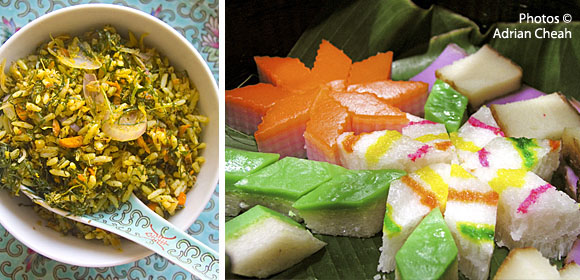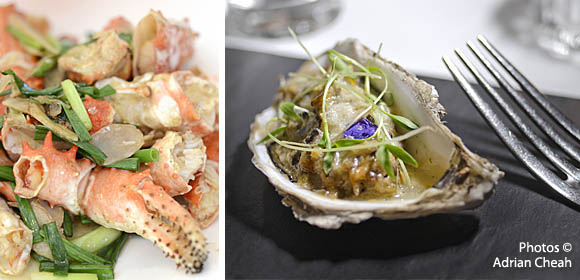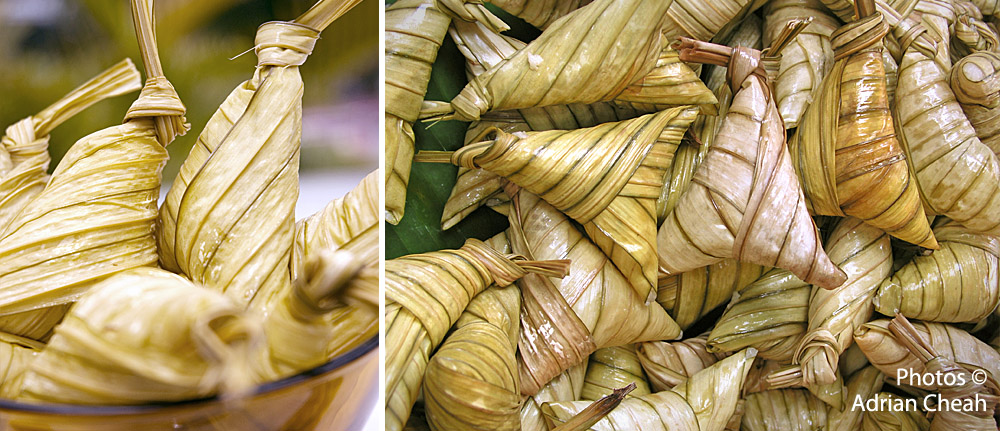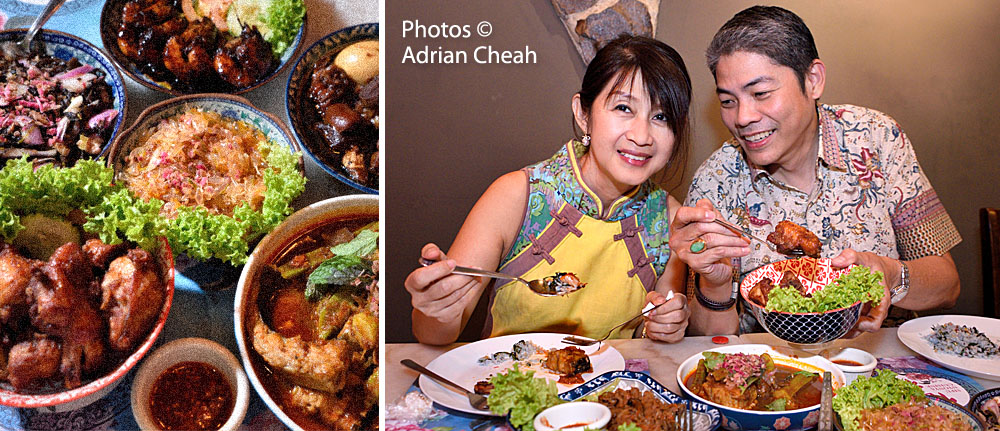Nasi lemak – a parcel of Malaysian goodness

A favourite breakfast dish for most Malaysians is Nasi Lemak – something which transcends the often-tenuous ethnic boundaries in this multi-racial country, as Malays, Indians and Chinese, all love it!

Having a reputation as a food paradise, be it haute cuisine, or cuisine bourgeoise (hawker fare), Penang offers a heady and exotic mix of delicious cuisine to choose from.
In a word, Penang food is both famous and fabulous. When people mention Penang food, they are more often than not referring to hawker food and coffee shop dining. It is true that some of the hype is overblown but it cannot be denied that Penang is home to many uniquely delicious chow. Ironically, hawkers in other states or towns have been known to pull the crowd by simply advertising their food as hailing from Penang, regardless of its authenticity or quality. Then there are the Penang hawkers who advertise their cuisine as specialties from another state, like Johor bak kut teh, Ipoh chicken and bean sprouts or laksa Kedah. In short, an infinite variety of dishes are yours to savour – all you need to do is pick and choose.

Penang hawker food can be broken down roughly into several varieties, with each being attributable to Penang's multi-cultural character: Nyonya, Chinese, vegetarian, Indian, Malay, Hakka-styled Western, seafood and desserts. Hybrids are also known to exist, and some famous examples are Malay-style chicken rice and char koay teow, and Chinese satay and nasi lemak. The prices are cheap and reasonable.

With fishing being a major economic activity on the island, Penang is naturally a haven for seafood, and a handful of restaurants have already achieved legendary status among locals and foreigners. Tucked away in remote corners, these eateries are not easy to find without local guidance but are definitely worth the extra effort to seek out.

Desserts play a major role in Penang gastronomy. There are as many varieties as there are races in Penang! To mention a few would do injustice to the rest, so you would just have to let your nose and eyes be your guide. A word of warning though – most local desserts tend to be sweet and rich, as coconut milk, flour and sugar are the main ingredients.

Thanks to early Chinese migrants, Chinese cuisine ranges from Cantonese to Teochew to Hokkien to Hainanese to Szechuan cooking. There's also Penang Nyonya food, which is a combination of Chinese, Malay and some Thai. The Penang variety of Nyonya food, apparently, is different from the Malaccan or even Singaporean versions. For a touch of luxury, try a five or ten-course Chinese meal at one of the restaurants or hotels in town.

Indian cuisine goes by two names generally – banana leaf rice and nasi kandar. Both are hot and savoury with rice being the main staple, and a menu from north Indian tandoori and nan bread, to South Indian rice and chapati.
Nasi kandar is famously popular with Penangites, and many restaurants selling it are well known not only to those on the island but those in other states as well. It is quite common to find people from other states detouring to Penang just to stop for a meal of nasi kandar before continuing on their journey elsewhere...
Indulge! Savour!
---------------------------------------------------------
Written and photographed by Adrian Cheah © All rights reserved
Updated: 6 March 2019

A favourite breakfast dish for most Malaysians is Nasi Lemak – something which transcends the often-tenuous ethnic boundaries in this multi-racial country, as Malays, Indians and Chinese, all love it!

If you are a tourist in Penang during Ramadhan, you have to add the Ramadhan bazaar to your list of must-see places. The month-long Ramadhan bazaar (opens from 3:30 – 7:30 pm) offers a wide variety of Malay specialities and it is a wonderful market to scout for delicious treats. Roti Jala is something I will usually buy among many others.

Satay is an example of how Penang cuisine was greatly influenced by the Arabs who came here to trade from the Middle East. Some say that this dish has Turkish roots. Be that as it may, satay has been available in Malaysia for many years already and is synonymous with Malay cuisine.

Kuih Bahulu (also known as Kuih Baulu or Kuih Bolu) is a perennial favourite among Malaysians of all ages. In Hokkien, it is called Kay Nui Koh. It is a mini light and fluffy sponge cake made from eggs, flour and sugar. It has a slightly crusty outer layer with a soft and fluffy inside, quite similar in taste and texture to a French Madeleine. However, when compared to many western cakes, Kuih Bahulu is much lighter in texture and has a subtle sweetness.

In Penang and across Malaysia the lemang is available all year round. Nonetheless, it has become a special dish during the Hari Raya celebrations – Hari Raya Aidilfitri (Eid al-Fitr) and Hari Raya Aidiladha (Eid al-Adha). Although its preparation seems simple enough, cooking lemang requires an open area with ample ventilation – which is why most people just prefer to buy lemang rather than attempt to make it themselves.

The most popular types of ketupat found in Malaysia are ketupat nasi (made with plain rice) and ketupat daun palas (made with glutinous rice). While both varieties are wrapped in palm leaves and then boiled, they use different types of leaves: ketupat nasi is typically wrapped in young coconut leaves (daun kelapa muda), whereas ketupat daun palas is enclosed in Licuala palm leaves (daun palas). It is said that ketupat daun palas originated from the northern states – Penang, Kedah and Perlis – while ketupat nasi is more popular in Perak.

Sifu Nyonya Cuisine, located at Jalan Pintal Tali, offers an authentic Nyonya dining experience. At the culinary helm of the restaurant is 71-year-old Madam Beh Geok Wah, whose culinary prowess is showcased through a menu featuring over 40 dishes. Some recipes are cherished heirlooms passed down through generations, ensuring that the essence of Nyonya cooking is preserved with every flavourful bite.

"Perhaps imagination is only intelligence having fun" – George Scialabba
The "love letter", more commonly known as kuih kapit (a paper-thin crispy, fan-shaped biscuit), is an essential feature during Chinese New Year. However, when a classic item like kuih kapit becomes deeply entrenched in tradition, introducing a daring innovation to reinvent it can evoke mixed reactions – either embraced with enthusiasm for its novelty or met with scepticism and disapproval.

A rendezvous with friends should always set the stage for a fun-filled outing. However, as true-blue Penangites, our palates demand nothing less than something seriously ho-chiak (delicious in Hokkien), the kind that commands attention above all else. This must be closely followed by the thrifty wisdom of value for money. Moreover, if an attractive ambience is coupled with warm friendly service, the escapade would indeed be a memorable one. Lotuss Nyonya Kitchen, located in the heart of George Town, seems to have it all.

Born into a Chinese Peranakan family, I often find my culinary cravings leaning towards other cuisines – whether it is Chinese, Thai, Italian, Japanese, Vietnamese, Continental, Mexican, Indian or Malay – when dining out, unless I am hosting guests from abroad who crave for Nyonya cuisine. Sometimes when time allows, I will gladly roll up my sleeves and prepare a Nyonya feast to ensure that they depart Penang with a lasting impression of the vibrant and unique flavours that define Nyonya cuisine.

In Malay, “bubur” means “porridge”. As "cha cha" is a homophonic with the Hokkien "che che" (meaning "abundance"), it is a dish synonymous with unity and happiness in abundance. Although there are various theories, there is no one definitive consensus on its origin or what the name of the dish actually means.

I truly believe that if one desires to live a purpose driven life, one has to wear one's heart on one's sleeve and allow passion to fuel the journey. One such brave man I know is Richard Rivalee, always smiling and bubbling with gaiety.